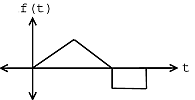| << Chapter < Page | Chapter >> Page > |
Of course, there is not necessarily exactly one instance of a target signal in a given signal. There could be one instance, more than one instance, or no instance of a target signal. Therefore, it is often more practical to identify all shifts corresponding to local maxima that are above a certain threshold.
The signal in [link] contains an instance of the template signal seen in [link] beginning at time as shown by the plot in [link] . Therefore,



Matched Filtering is used in image processing to detect a template image within a reference image. This has real-word applications in verifying fingerprints for security or in verifying someone's photo. As a simple example, we can turn to the ever-popular "Where's Waldo?" books (known as Wally in the UK!), where the reader is tasked with finding the specific face of Waldo/Wally in a confusing background rife with look-alikes! If we are given the template head and a reference image, we can run a two dimensional convolution of the template image across the reference image to obtain a three dimensional convolution map, [link] , where the height of the convolution map is determined by the degree of correlation, higher being more correlated. Finding our target then becomes a matter of determining the spot where the local surface area is highest. The process is demonstrated in [link] . In the field of image processing, this matched filter-based process is known as template matching .


then we could easily develop a program to find the closest resemblance to the image of Waldo's head in the largerpicture. We would simply implement our same match filter algorithm: take the inner products at each shift and seehow large our resulting answers are. This idea was implemented on this same picture for a Signals and Systems Project at Rice University (click the link to learn more).
What are the advantages of the matched filter algorithm to image detection? What are the drawbacks of this method?
This algorithm is very simple and thus easy to code. However, it is susceptible to certain types of noise - for example, it would be difficult to find Waldo if his face was rotated, flipped, larger or smaller than expected, or distorted in some other way.
Matched filter detectors are also commonly used in Communications Systems . In fact, they are the optimal detectors in Gaussian noise. Signals in the real-world are often distorted by the environment around them, sothere is a constant struggle to develop ways to be able to receive a distorted signal and then be able to filter itin some way to determine what the original signal was. Matched filters provide one way to compare a receivedsignal with two possible original ("template") signals and determine which one is the closest match to the receivedsignal.

Notification Switch
Would you like to follow the 'Signals and systems' conversation and receive update notifications?